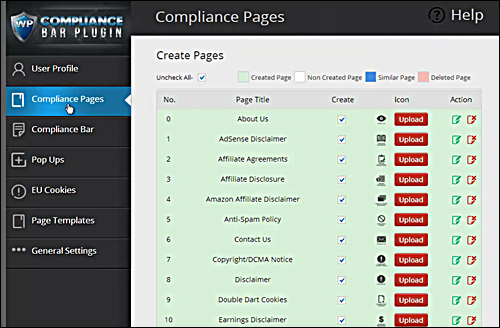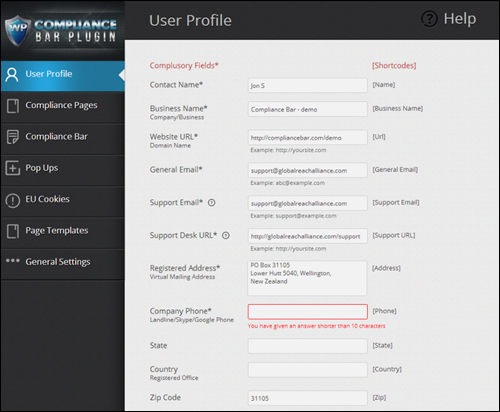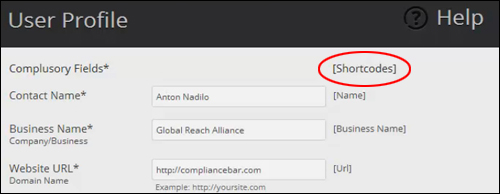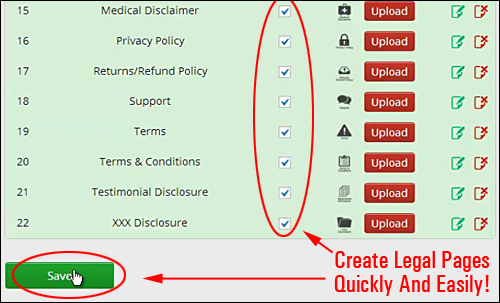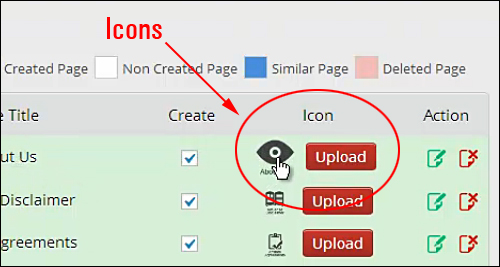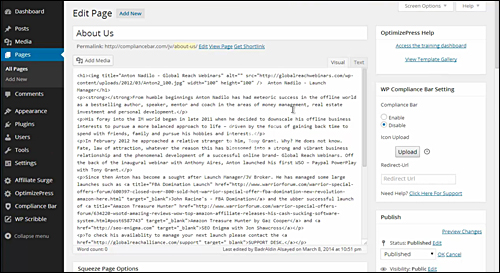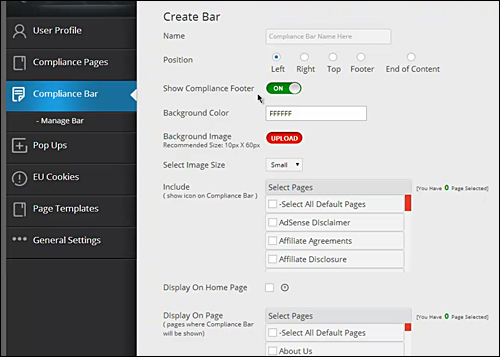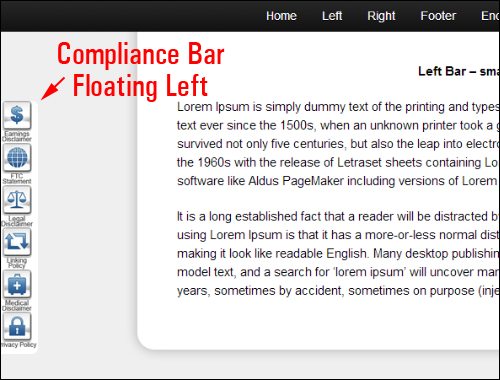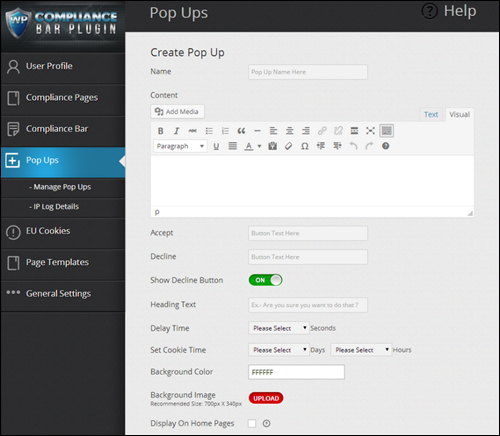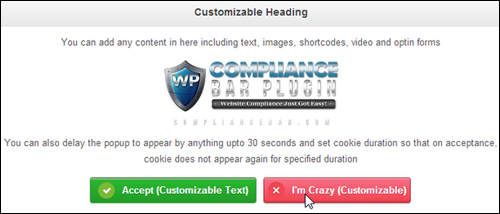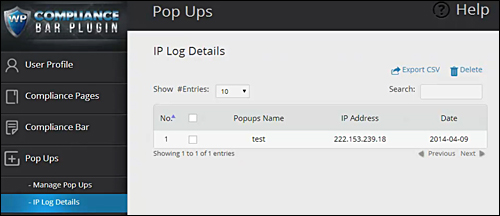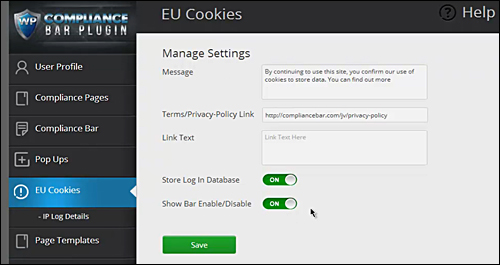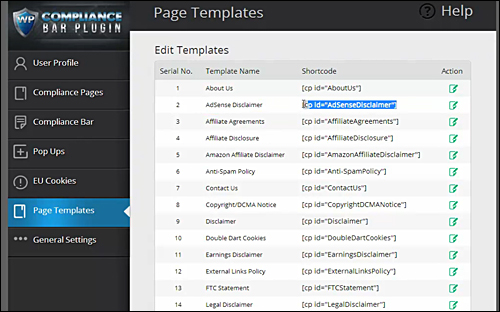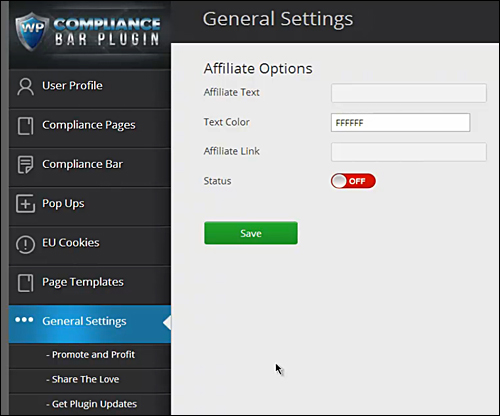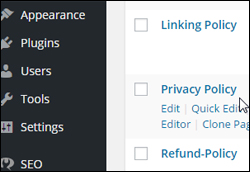 One of the worst situations you can find yourself in as a website owner is to break the law.
One of the worst situations you can find yourself in as a website owner is to break the law.
If your website isn’t compliant with laws designed to protect consumer rights, you’re breaking the law.
Being non-compliant puts you at risk of suffering significant financial losses and the cost to your reputation. Why risk your money and your business reputation, when you can protect yourself so easily and inexpensively?
In this article, we look at a simple and very inexpensive WordPress solution that can help make your website fully compliant in minutes.

Is Your Website Or Blog Legally Compliant?
As the digital business realm continues growing at breakneck speed and the rules of the game are constantly changing, it’s important that you stay informed about what’s going on and to make sure that your website or blog remains legal, especially if your digital presence is an integral part of your overall business strategy.
If there are no legal pages on your website (e.g. terms of service, privacy policy, financial disclaimers, etc.), many sites like Google won’t let you advertise, sites like ClickBank won’t approve your digital products for sale, PayPal could close down your account and withhold payment of your funds, Facebook and many other social sites will suspend your applications, and you won’t be allowed into a range of advertising or affiliate marketing networks.
Plus, you could also be inadvertently leaving yourself open and vulnerable to lawsuits or legal action.
At the very least, without making it clear to your visitors that your website complies with legal requirements and regulatory guidelines, trust and confidence in your business could be irrepairably.
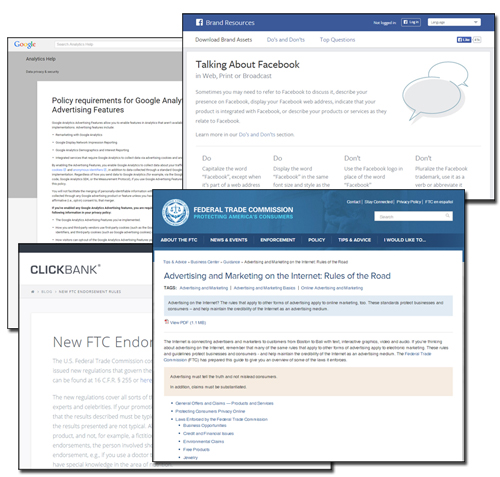
(In addition to legal and regulatory compliance, almost all 3rd-party services require you to comply with their terms of use!)
![]()
Legal Disclaimer: Please note that we are not lawyers and we are not offering legal advice here.
The purpose of this article is to make you aware that:
- Your website may be subject to various legal requirements in accordance with compulsory federal, state or local laws that govern your business (some of which you may not even be aware of),
- How important it is to maintain compliance with the terms of service of third-party providers whose products or services you may be promoting or endorsing online, and
- There are solutions that can help your site become compliant, such as the solution that we review in this article.
If you suspect that your web site lacks in areas of compliance, below we review a simple plugin for WordPress websites that you should know more about.
Presenting …
Compliance Bar – Compliance Plugin For WordPress
Plugin Description
The Compliance Bar WordPress Plugin is a complete compliance & disclaimer solution for your online presence …
Learn more about the plugin here: Compliance Bar
Plugin Benefits
Here we have listed just some of the many benefits and advantages of using Compliance Bar to instantly make your website or blog legally compliant:
Ready To Use In Minutes
Compliance Bar Plugin installs like every other plugin. Simply upload the plugin file to your Plugin folder via your WP dashboard and activate.
Easy To Edit Page Templates
Easily edit the prebuilt templates inside the plugin from the settings menu with the WordPress visual editor.
24/7 Support
The plugin developers provide dedicated plugin support to help you.
Additional benefits and advantages include:
- Customized Legal Pages: The Compliance Bar plugin creates your legal pages in seconds and customizes them to your business and website.
- Full Video Training Manuals: Compliance Bar is not difficult to use - an entire library of training videos is provided.
- Can Be Used In All Countries: As long as you consult a qualified legal representative to make sure that the built-in templates provided with the plugin are suitable and satisfactory for your business, country and website, you can use the plugin wherever you are located.
- Use On All WordPress Sites: As long as your website or blog is built with WordPress, you can use the plugin for all kinds of websites. Just select the templates you want to include in your site and leave out any unnecessary pages.
Features
Compliance Bar Plugin offers many great features to web site owners. Below we have listed just a few:
- Fast and simple to install and configure. Be up and running in minutes.
- Display Attractive Icon Bar – Display links to your compliance pages in the form of attractive icons that can be placed anywhere on your pages. You can also upload your own icons.
- Display Sensitive Content – If you plan to display content that needs to be restricted to certain age groups (e.g. content related to alcohol, ecigs, dating, etc.), you can display pop-ups that require users to accept your site’s terms or disclaimers.
- EU User Cookie Compliance – If you are based in the EU or display your content to EU visitors, you must make users aware of your user cookies and notify them of how you use them. Compliance Bar displays an attractive bar notifying visitors and covering you from non-compliance issues.
- Records & Stores IP Addresses – The plugin records the IP addresses of your visitors for reference, just in case a user accepts your terms or disclaimers and then claims they didn’t.
- Shortcode Driven – The plugin is integrated with shortcodes that populate the templates with your personal information. These shortcodes also allow you to place information anywhere on your website, (including the popups).
- Mobile Friendly – Compliance Bar has individual settings for displaying on mobile devices and displays mobile optimized icons automatically depending on the mobile browser being used.
Using Compliance Bar
Once you have installed the Compliance Bar plugin, a section where the plugin’s settings can be configured is added to your WordPress dashboard.
Let’s review these settings briefly …
User Profile
There are a number of default categories in this screen where you can enter your business information into entered (e.g. “Website URL,” “Support Desk URL,” “Contact Phone,” “Refund Duration (Days),” etc.). Not all categories are compulsory, but some are (e.g. “Website URL,” “Support Email,” etc.)
(Compliance Bar User Profile Section – Image source: plugin documentation)
The Compliance Bar Plugin uses shortcodes to insert the information from your User Profile fields into your legal pages …
(Compliance Bar Plugin User Profile Section: Shortcodes – Image source: plugin documentation)
Once the minimum required information has been entered into the plugin settings fields, users can then access the other plugin section.
Compliance Pages
The “Compliance Pages” screen includes a list of all of the templates …
(Compliance Bar: Legal Templates – Image sourced from plugin documentation)
Here’s the complete list of template pages made available by the plugin last time we checked their site:
- About Us
- AdSense Disclaimer
- Affiliate Agreements
- Affiliate Disclosure Statement
- Amazon Affiliate Disclaimer
- Anti-Spam Policy
- Contact Us
- Copyright/DCMA Notice
- Disclaimer
- Double Dart Cookies
- Earnings Disclaimer
- External Links Policy
- FTC Statement
- Legal Disclaimer
- Linking Policy
- Medical Disclaimer
- Privacy Policy
- Returns/Refund Policy
- Support
- Terms
- Terms & Conditions
- Testimonial Disclosure
- XXX Disclosure
Creating legal pages for your website is a simple process. Just select the check boxes next to the pages you want to create and click ”Save” in the “Compliance Pages” screen …
(Compliance Bar: Legal Templates – Image sourced from plugin documentation)
Your legal pages will then be created and added to your “Pages” section.
Compliance Bar Icons
The plugin comes with a built-in set of attractive icons for referencing your legal pages …
Icons are customizable. You can purchase additional icons from the plugin developer, or create/upload your own to match the style of your site’s design …
(Compliance Bar Plugin: Compliance Page Icons – Screenshot source: plugin documentation)
Edit / Delete Compliance Page Templates
You can modify and delete your compliance templates from the “Compliance Pages” tab, just as you would any other page in WordPress …
(Compliance Bar Plugin: Edit Legal Templates – Image source: plugin documentation)
![]()
Notes
- Editing the legal pages is recommended, as the pages contain generic content.
- The plugin indicates if it detects existing similar pages on your site (e.g. pages created before installing the plugin).
Compliance Bar
You have many options to customize the Compliance Bar, including where to position the bar, displaying links or icon images, background colors and images, image size, selecting which pages should be included in the Compliance Bar, whether or not to display the Compliance bar on your front page, which pages the Compliance Bar will display in, mobile settings, and more …
(Compliance Bar Section: Create Bar – Image source: plugin documentation)
Notes:
- You can create several Compliance Bars to display different icons on different pages, or to cover various uses throughout your website.
- The plugin allows you to display the Compliance Bar on the front page of your site, even if you are using particular 3rd-party themes (like Genesis, Thesis or Woo), where the home page is configured through the theme itself as a built-in template, and not as a normal “static” page.
- Due to the smaller size of mobile screens, there is a limit to the number of page icons you can display if you turn Mobile Settings “on.”
Once you have configured your Compliance Bar settings, it will display links to your legal using a visually attractive icon bar on your site …
You have complete control over the location on your pages where you would like to feature your compliance icons …
PopUps
If you plan to publish content that needs to be restricted to certain age groups (e.g. information related to alcohol, tobacco, dating, etc.), Compliance Bar can display popups that force users to accept your website’s terms or disclaimers.
The “Create Pop Up” screen gives you full control over the settings and wordings of your pop ups …
(Pop Ups Section: Create Pop Up – Image sourced from plugin documentation)
You can create a number of customized Pop Ups displaying on different pages, or to cover different uses in other areas of your website …
You can also specify a delay time if you don’t want a Pop Up to display immediately, set a cookie duration to prevent Pop Ups from displaying again within a specific time interval, and record the IP addresses of visitors who accept your terms and disclaimers for future reference …
(Pop Ups Screen: IP Log Details – Image sourced from plugin documentation)
EU Cookies
If you do business in Europe or display your content to EU visitors, you need to make users aware of your user cookies and notify them of how you use them …
Compliance Bar lets you manage the settings for compliance with EU Cookies requirements, including the wording of your notification message and link text in the “EU Cookies” area …
(EU Cookies Screen: Manage Settings – Image sourced from plugin documentation)
Compliance Bar has a non-intrusive way of notifying your visitors and covering you from non-compliance.
Page Templates
The “Page Templates” tab, lists all of your legal pages and shortcodes, and lets you edit their content …
General Settings
The “General Settings” section, gives you access to general information, such as promoting and sharing the plugin and getting plugin updates …
User Feedback
Here are a couple of the testimonials plugin customers have provided for the Compliance Bar plugin:
”When I got my hands on Compliance Bar, I knew I needed help to be compliant, but I had no idea how much danger I was in, nor did I know all of the different things I needed to be compliant. Once I installed Compliance Bar, I was able to very quickly add all the items I needed to ensure I didn’t end up getting fined by various agencies, or have my site pulled from Google. The best part is that getting it all set up took only minutes, and I know that I am far safer than I was. Compliance Bar is one of the best plugins I have used in a long time.” Ray Lane – (The Video Guy)
***
”Truly Amazing Product!” Patrick Mauchant – PT Enviromate Technology
Useful Tips
Below are a few useful ways you can use Compliance Bar:
- Protect against content theft by spelling out terms of use of your website.
- Display compliance icons only on specific pages.
- Minimize refund disputes by clearly spelling out refund terms before purchase.
- If you have content for adult viewers on your website, you can force visitors to click to confirm that they are of legal age to view your content.
Compliance Bar Support
Plugin Developers provide users with dedicated plugin support to help you if you experience any difficulties. Users also get access to a complete library of training videos.
Additionally, your purchase is backed by a risk-free, thirty day, 200% refund guarantee. If your version of Compliance Bar does not work within 30 days of purchase and it cannot be fixed within 48 hrs (Monday to Friday), your purchase price will be refunded in double.
Product Licensing Cost
- Single – Install the plugin on one site that you own. Cost = $37 (Normally $127)
- Business License – Install the plugin on twenty-five sites that you own. Cost = $67.00 (Normally $197).
- Developer – Install the plugin on all domains that you own. Can be installed on all client sites as part of a paid service. Price = $97.00.
Note: Current pricing for Compliance Bar depends on whether there are any promotions or limited-time special offers. Presently, the plugin retails for the amounts shown above. This may or may not be the actual price set by the product developer when you visit the website and you may be shown additional upsells or one-time offers after you’ve purchased.
Check the plugin’s website for the latest pricing here: Compliance Bar – WordPress Plugin For Website Compliance
Additional Plugin Info
Legal Templates Approved By Lawyers – The plugin developers state on their website that all legal page templates have already been reviewed and approved by lawyers. Nonetheless, we strongly recommend that you get legal advice from a qualified legal expert in your area for peace of mind.
For demo videos showing how the plugin works, including installation instructions and tutorials, FAQs, support help desk, contact details and more, visit the Compliance Bar website.
Install The Plugin
Compliance Bar is an easy-to-use, simple and cost-effective solution for WordPress-powered websites and blogs. We recommend installing this plugin for WordPress users if you want immediate peace of mind and legal protection.
For more details, visit the plugin website here: Compliance Bar – Compliance Bar – WordPress Website Compliance Plugin
![]()
Note: Once again, we are not lawyers and we are not offering legal advice on our website. Do your own due diligence and consult a legal expert about the best way of ensuring that your website fully complies with the law wherever your business is based.
***

